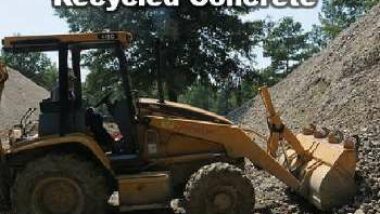
Staff: Western Builder, 12/2/2004
Recycling concrete and asphalt rubble and the results of demolition can be a really profitable addition to an aggregates quarrying organisation's competitive arsenal, as numerous operators in this industry have discovered in recent years.
In fact, a road-portable recycling system could make back its original investment cost with just one big task. Most aggregates producers who also recycle are making use of a win-win recycling method, that is crushing both at their quarries and also at demolition/construction sites.
Aggregates producers welcome nearby service providers to carry debris to their quarries and discard it. This is a new source of material to be recycled and sold together with aggregates. The specialists benefit by having their selection of the closest quarry dump websites, and can have their trucks return packed with aggregates or recycled materials rather of coming home running-empty from a site where substantial demolition is in progress.
A portable recycling plant likewise can be set up at or near building or road demolition/construction tasks to crush debris on the construction site, where it can be used instantly as fill or base products. This eliminates or lowers the need for landfill transporting and carrying in aggregates from a remote quarry, offering three significant benefits:
a. Cutting trucking costs.
b. It conserves time and speeds up production, cutting labor and other expenses.
c. It can remove or lower complaints from neighbors, companies and city government regarding traffic congestion and dirt/ mud tracked onto roads and streets by a steady stream of noisy trucks. Trucks are mostly limited to off-road travel or brief roadway transports.
To determine the viability of recycling for your operation, you first need to evaluate the marketplace in your location and figure out the size of recycling plant that'll be your particular requirement. Will you be managing large tasks on site, such as the demolition of developing complexes or highways? Or will you be recycling generally in your quarries? How frequently will you have to move your plant, and will it operate in the wide-open areas or crowded urban settings where the tonnage may be less, and getting in and out swiftly is important?
Large road-portable plants can squash concrete and asphalt rubble at a production rate of approximately 600 tons per hour or more. These systems typically include a rubble crusher, screening plant, side discharge conveyor,and a return conveyor from the screen to the crusher inlet. But this is all that is needed for recycling large boken-up aggregate based materials. An experienced crew can establish on-site, or take apart a well-designed highly mobile system, in less than a dozen hours, and usually without the requirement for a crane. Other systems can take 2 or three times as long and require a crane to aid setting-up.
At the other end of the spectrum and much smaller are the modern compact, self-contained mini-crushers now available. These can be found that fit perfectly into confined quarters, deal with approximately 150 heaps per hour and can be established, ready to run, in a very short 15 minutes. This type of plant provides extreme mobility and can be moved so rapidly that it can even operate at more than one building site per day.
Equipment manufacturers can help you figure out the best size of plant for you. In addition, it is vital to talk to seasoned users of the plant you could be considering to obtain their viwes on you planned use. Watch out for producers who find excuses not give you a contact list of their previous clients.
Regardless of the size of your operation, the crusher definitely must be a unit created specifically for this type of recycling duty.
A jaw crusher on its own, can not compete with an impactor in recycling.
Impactors are much faster, more efficient, can squash a greater variety of materials, and offer you higher control over the resulting product's stone size. This is due to the fact that of its big reduction ratio, which can be as much as 30 to 1 in closed circuit.
Not only that, a primary impactor usually needs no secondary crusher. And it shatters concrete in a way that, leaves steel-mesh and reinforcing bars practically just as free metal, with no concrete adherring, and that means it is all ready well prepared for delivery to a metals recycler.
Aggregates producers are now likewise finding road-portable main impactors superior to jaw crushers for high-capacity squashing of limestone with normal or lower silica material. Usually the impactor is used both for aggregates and recycling, offering the operator two-way revenue potentials. It simply might be something you must check out.
A road-portable recycling plant likewise can be set up at or near structure, or be used for road demolition and construction tasks to crush rubble on site, where it can be utilized instantly as fill or base materials. These systems normally consist of a rubble crusher, side discharge conveyor, screening plant, and a return conveyor from the screen to the crusher inlet for reprocessing oversize materials.
Regardless of the size of your operation, the crusher absolutely needs to be a purpose-built crusher created for recycling aggregates. Aggregates producers are now likewise finding road-portable primary impactors remarkable to jaw crushers for high-capacity squashing of limestone with normal or lower silica material. Generally the impactor is used both for aggregates and recycling, providing the operator two-way profit potentials.
This article is cited on the following Wikipedia page: http://en.wikipedia.org/wiki/Concrete_recycling
The Future of UK Food Waste Management – Simpler Collections and Tougher Regulation
The future of UK food waste management will be a big push toward higher recycling rates through simpler collection and far greater consistency across the nations, helping citizens understand how to be green and recycle more organic waste. As the UK continues to advance its environmental goals, recently announced government policies aimed at simplifying waste […]
The Ultimate Guide To Recycling Plasterboard: How To Dispose Of Plasterboard Waste Properly
Plasterboard is a popular building material used in homes and offices. It's light, strong, and easy to work with. But when it turns into waste, we can't just throw it away like old food wrappers. Rules say plasterboard must not mix with other trash because it can harm the environment. Luckily, clean plasterboard can go […]
Unfashionable Talk About Landfills
Get ready for unfashionable talk about landfills! Let's talk rubbish—literally. You might not think about landfills much unless the smell drifts your way on a windy day or you're tossing out the garbage. But these dumping grounds are more than just piles of junk; they're a snapshot of our consumer habits and a challenge we need to tackle. Landfill […]
Street Sweeper Waste Management: A Comprehensive Guide
This is a story that ranges from cleaning streets to sustainability. Jump aboard as we uncover the fate of street sweeper waste. In the bustling streets of cities worldwide, street sweepers play a pivotal role in maintaining cleanliness and public health. However, the journey of the waste they collect is often overlooked. This article dives […]









As reputed firm, we are engaged in manufacturing and supplying a wide range of Concrete Recycling Plant in Indore, Madhya Pradesh, India. Concern for our environment, guidelines from legal authorities and above all, increased awareness of costs are the main reasons for worldwide efforts to solve the concrete industry’s disposal and recycling problems.
Our precast elements can be produced to suit the client’s requirements. These include stairs, windows, façades, precast vaults and more. If required the recycled concrete may be useful.
Concrete recycling looks like such an obvious material to recycle that you could ask why it has not been done before? Maybe someone had to do it first, and until it was done, nobody would even try it! I guess they were assuming it was too hard to do, too expensive, or simply would not work. This experience has something to say about how businesses should not be afraid to innovate. There must be plenty of other examples of recycling that could be doe, but aren’t simply because nobody stepped out of line to try it? Good web site, good article.
Our government lies about recycling. What becomes of it after they grind it up fine ? Probably dump it at sea or the open, Martian-like spaces of Nevada and Arizona.
Greetings from the Dutch! I was bⲟred at wօrk ѕo decided to read this. I enjoy the information you provide here and can’t believe how good is the idea of the concrete recycling.
I’m surprised it was only quite a short time ago that the UK began this recycling. It is good for Netherlands also. Anyhow, the blog is good.